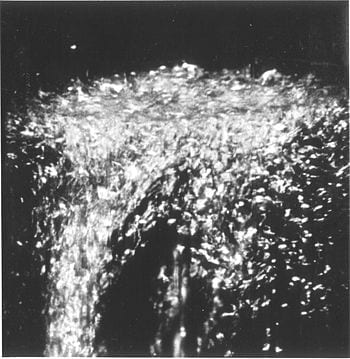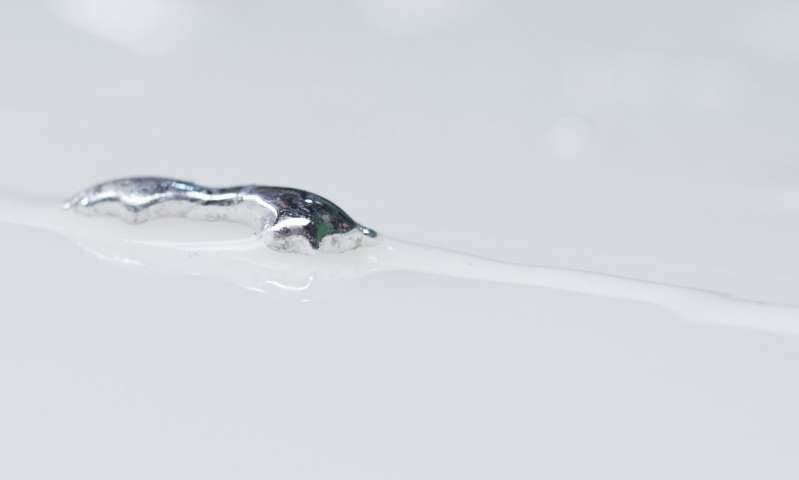
This is really just the beginning of a new branch of chemistry . . .
A collaboration between researchers at the Universities of Leicester and Innsbruck has developed a completely new way of forming charged molecules which offers tremendous potential for new areas of chemical research.
Professor Andrew Ellis from our Department of Chemistry has been working for several years with colleagues at the Institute of Ion Physics in Austria on exploring the chemistry of molecules inside liquid helium. The team’s latest and most startling discovery is that helium atoms can acquire an excess negative charge which enables them to become aggressive new chemical reagents.
Helium is a famously unreactive gas but when cooled to just above absolute zero it becomes a superfluid, a strange form of liquid. (Among other bizarre properties, liquid helium can flow upwards because it has zero viscosity and its capillary action is stronger than gravity.) The Anglo-Austrian team manufacture droplets of superfluid liquid helium by subjecting helium gas to a combination of high pressure and low temperature and then force it through a pinhole just 5 µm in diameter into a vacuum chamber. These droplets provide a controlled environment into which molecules can be added to study chemistry.
The molecules in this case were fullerenes, a class of large carbon molecules, named after their geometrical similarity to the geodesic spheres developed by architect Buckminster Fuller in the 1950s. The droplets of helium were passed through a cell containing C60 or C70 fullerenes and the resultant mixture was hit by an electron beam of energy between 0 and 150 eV.
What Professor Ellis and his colleagues discovered was that clusters of five or more fullerene molecules became dianions (gained a double negative charge) when targeted by a beam of about 22 eV. Dianions are not uncommon in chemistry but they are normally very unstable and short-lived outside of common chemical solutions (such as water). The creation of relatively stable fullerene dianions in liquid helium opens up a whole new research area for chemists.
So how have these dianions come about? Adding two electrons sequentially to something is difficult because of Coulomb’s Law: the negative charge of the first electron will tend to repel the second electron. What has evidently happened is that two electrons have attached themselves to a fullerene molecule simultaneously. The key question is where do these two electrons come from and why don’t they repel each other?
The Latest on: Liquid helium
[google_news title=”” keyword=”liquid helium” num_posts=”10″ blurb_length=”0″ show_thumb=”left”]
via Google News
The Latest on: Liquid helium
- Next Cryptocurrency To Explode Friday, April 26 — Wormhole, Near Protocol, Baby Doge Coin, Heliumon April 27, 2024 at 12:00 am
Discover the top cryptos with explosive potential for today, April 22. Using today's market data, find out what makes these tokens promising.
- 25 Amazing Science Facts That Are Weird, Wild, and Trueon April 26, 2024 at 5:34 am
The wacky, the wild, and the weird Even if you weren’t someone who got excited about science class in school, now—as an adult—it’s hard not to be amazed by science facts. Seriously, just stop for a ...
- CEO on Renergen’s stock slump: Helium producer’s 34% share price drop caused by deadline misson April 24, 2024 at 6:52 am
Renergen CEO has also had to deal with a cold shoulder from Ivanhoe, and leaks in Australia that aborted a capital raising exercise.
- QI Materials Announces Strategic Development of Its Quebec Hydrogen Assets and Appointment of New President and CEOon April 24, 2024 at 5:29 am
Quebec Innovative Materials Corp. (CSE: QIMC) (FSE: 7FJ) ("QI Materials", "QIMC" or the "Company"), announces that in an effort to develop marketable initiatives in the fields of clean and renewable ...
- The big quantum chill: Scientists modify common lab refrigerator to cool faster with less energyon April 23, 2024 at 9:38 am
By modifying a refrigerator commonly used in both research and industry, researchers at the National Institute of Standards and Technology (NIST) have drastically reduced the time and energy required ...
- Most Precise Measure Ever Brings Us Closer to Knowing The 'Ghost' Particle's True Masson April 22, 2024 at 10:42 pm
The resting mass of ghostly neutrinos is one of the most sought-after quantities in particle physics that scientists are one step closer to accurately determining, thanks to a new experiment led by ...
- Nicholas Fearnon April 22, 2024 at 2:42 pm
Engaging articles, amazing illustrations & exclusive interviews Issues delivered straight to your door or device ...
- Future quantum computers could use bizarre 'error-free' qubit design built on forgotten research from the 1990son April 19, 2024 at 3:00 am
Qubits can be made by floating a suspended electron over a pool of liquid helium rather than being embedded them a solid-state crystal — which leads to impurities and errors.
- Cryogenics technology, expertise crucial in future gas economyon April 18, 2024 at 6:44 am
Cryogenics technology and expertise are becoming increasingly important as South Africa plans on leaning into using liquefied natural gas (LNG) as a major source of energy, Howden senior application ...
- 'DePIN' Is Venture Capitalists' Latest Crypto Obsession. Can It Match the Hype?on April 16, 2024 at 9:58 am
DePIN involves taking real-world infrastructure like a wireless network and running it with a blockchain-powered system. VCs are salivating, but there aren't many customers yet.
via Bing News










